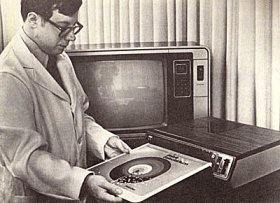Capacitive discs store information as variations in electrical capacitance, detected by a stylus
which forms part of a resonant electrical circuit that includes both the disc and the player.
The basic idea of CED was to make both the discs and the players as simple and cheap as possible, with all the expensive and high-tolerance parts kept in the factory, rather than the user's home. So, the discs would be like audio records, a mass-market product which would be cheap enough to sell in large numbers in a short space of time.
|
The first capacitive disc format was developed in the US by RCA, under the name SelectaVision - the same name as their
long-obsolete holographic tape system (see the First Videocassette Revolution),
and also the name they used for their first VHS decks! The SelectaVision Disc format was launched in the US in March 1981,
and marketed in the UK in 1983 under the name CED (Capacitance Electronic Disc) by Hitachi and GEC McMichael.
A prototype CED player
In this version the discs would be put on a turntable just like audio records |
 |
| CED was expected to beat the more complex LaserVision system to market, and
hence become the de-facto standard for home video players. But theoretical work on producing discs, using a high-tech
electron diffusion technique, turned out to be unworkable in practice - only 5% of test discs played at all, and they would
fail for no obvious reason even when stored properly and not played. |
 |
Eventually, RCA went back to simpler techniques,
pressing discs in the same way as LP records (which they had been told was impossible) and coating them with carbon (which
they had been told wouldn't work), and the format was eventually launched in 1981 in the US and 1983 in Europe. A
substantial catalogue of discs were available - about 270 in the UK and over 1700 in America.
Testing a prototype of the first player
Note that the disc is now protected by a caddy |
But, by this time they were not only competing with LaserVision but both were suffering from the unexpectedly
rapid success of video tape, and just a month after RCA had publicly given assurances of their continuing support for the
system, it was suddenly scrapped (on both sides of the Atlantic) in April 1984.
In the dying days of the format, players were being sold off cheaply, and this gave a boost to the sales of discs. Disc production actually increased for a while; the last disc released was The Jewel Of The Nile, in 1986. RCA also produced a final souvenir disc, Memories of VideoDisc, which was given to employees who had been involved in the project.
|


